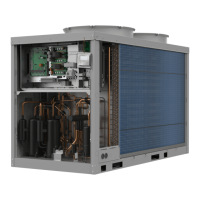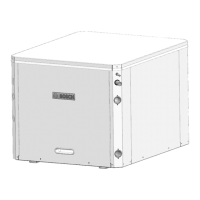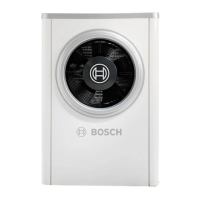Electrical connection
Compress 5800i AW – 6721862724 (2023/06)
20
Table 8 Cable area and cable type
Fig. 24 Wire striping mains feed connection
6.10.2 Connect the indoor unit
NOTICE
Risk of material damage due to a short circuit!
The insulation can melt on cables that touch hot surfaces and then cause
a short circuit.
▶ The cable routing must be done in such a way that the cables don’t
touch hot surfaces like pipes or the booster heater.
Cable ties must be used to fix the cables to the given fixing points.
1. Remove the electrical box cover.
2. Route the cables from the cable inlets to the electric box:
– Feed the connecting cables over the cable feeds on the bottom of
the indoor unit. See figure 25 for the correct order of the cables.
– Fix the cables with cable ties at the fixing points (Figure 25 [3],
Figure 26 [2], [4]). Avoid crossing the cables.
– Route and fix the cables inside the indoor unit (Figure 26).
– After inserting the cable, tighten the cable gland (Figure 25
[1])
3. Feed the cables into the electric box (Figure 27).
4. Connect the cables according to the chapters 6.10.4 – 6.10.4.
5. Reattach the cover of the electric box.
Fig. 25 Cable inlets to the indoor unit
[1] 400V~3N, input to indoor unit (booster heater)
[2] Fixing points on sheet metal plate for fixing the cables with cable
ties
[3] 230V~1N, output to DHW circulation pump PW2
230V~1N, output from PK2, cooling season
230V~1N, relay output for circulation pump PC1, heating circuit
230V~1N, output to accessory module
[4] CAN-BUS cables
[5] T0: Temperature sensor, flow
T1: Temperature sensor, outdoor
TW1: Temperature sensor, DHW
TW2: Temperature sensor, DHW
MD1: Condensation sensor (accessory for cooling mode)
I1-I4: External inputs
EMS-BUS cable for accessory
Option 1:
9kW
Option 2:
(3kW only)
Function Indoor unit Indoor unit
Cable type
Terminals
allow use of
fine-stranded
or solid core
wire
According to local rules
and regulations
If fine-stranded wires are
used:
▶ for ambient
temperature <30 °C:
use cables with
temperature
resistance ≥80°C!
▶ for ambient
temperature
≥30°C
1)
: use cables
with temperature
resistance ≥85°C!
1) Please note that the maximum ambient temperature of the appliance must not
exceed 35 °C
According to local rules
and regulations
If fine-stranded wires are
used:
▶ for ambient
temperature <30 °C:
use cables with
temperature
resistance ≥80°C!
▶ for ambient
temperature ≥ 30 °C
2)
:
use cables with
temperature
resistance ≥85°C!
2) Please note that the maximum ambient temperature of the appliance must not
exceed 35 °C
Cable
diameter
5 x 2,5 mm
2
3 x 2,5 mm
2
Fuse and
maximum
external load
3)
3) External load to outputs
3x16A: max. 210W
3x20A: max. 500W
1x16A: max. 135W
1x20A: max. 500W
≤10 mm
≤120 mm
0010048737-001
1 5
4
0010049178-002
23

